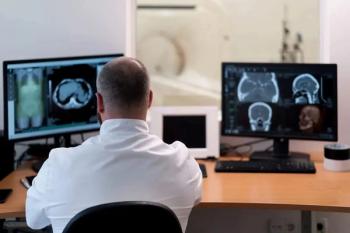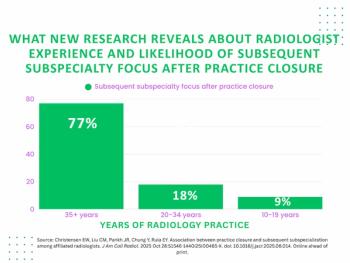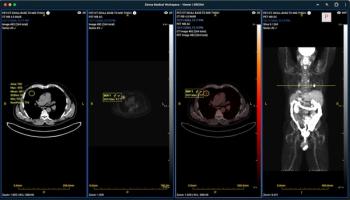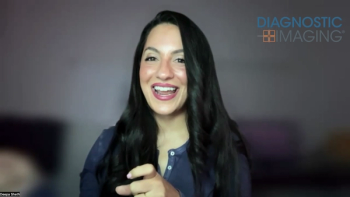
8 Reasons Why Radiology’s Future Is Bright
CHICAGO-Be optimistic about radiology’s future.
Recent years have seen many discussions about the challenges facing radiology and its up-and-coming practitioners. Fears about compensation, commoditization, and loss of prestige have had many in the industry wringing their hands about the specialty’s future. But, that future is actually quite bright.
According to Jonathan Berlin, MD, MBA, FACR, radiology professor at NorthShore University HealthSystem, at RSNA 2015, each issue causing concern throughout the industry has a silver lining that should prompt current and future radiologists to be optimistic about where the specialty is headed.
1. Compensation: It’s true, Berlin said, that radiology reimbursement has been declining in recent years, largely due to bundled payments and the multiple procedure payment reduction (MPPR). And, the drop threatens radiologists’ salaries. When compared to other specialties and professions, though, radiologists don’t have much to worry about.[[{"type":"media","view_mode":"media_crop","fid":"43855","attributes":{"alt":"","class":"media-image media-image-right","id":"media_crop_1585652554303","media_crop_h":"0","media_crop_image_style":"-1","media_crop_instance":"4864","media_crop_rotate":"0","media_crop_scale_h":"0","media_crop_scale_w":"0","media_crop_w":"0","media_crop_x":"0","media_crop_y":"0","style":"float: right;","title":"Jonathan Berlin, MD, MBA, FACR","typeof":"foaf:Image"}}]]
In 2012, radiologists earned, on average, $315,000, he said, compared to the national average of $71,000 annually for a family of four. In fact, radiology salaries ranked evenly with orthopedists and above cardiologists and plastic surgeons.
“Even if radiology incomes drop, radiologists will still be significantly above comparative careers that require professional degrees,” he said.
2. Increased Workload: Nearly any mid-career radiologist will attest that today’s workloads are heavier. There are more films to read and fewer people on each shift to read them. But, residents and fellows should take heart that the work is interesting and important, he said, and it offers a great deal of diversity. For example, they will have the opportunity to engage in clinical, research, teaching, consulting, quality supervision, administrative, and entrepreneurial work throughout their careers.
And, it will be possible that they could make a significant impact on someone’s life.
“Who doesn’t enjoy it when they flash on a case?” he said. “One to two times in your career you might get a letter or phone call from someone thinking you for saving his or her life.”
3. Commoditization: Much has been lamented in recent years about the commoditization of radiology. But, anything that is commoditized can be de-commoditized, Berlin said. Radiologists should take this opportunity to showcase the value the specialty brings to health care, including new low-dose technologies, improved wait times, and enhanced patient experiences.
Some offices, he said, are providing free Wi-Fi and workspaces for patients in waiting rooms, as well as play areas for children. Others show slide shows with practice information to familiarize patients with who will be part of their imaging care.
4. Outsourcing: Many residents lament that radiology shops are shipping overseas, but the greater threat, he said, is nighthawking. Often, a practice loses business to another practice just down the street that’s willing to work nights. If your practice doesn’t offer night service, now might be a good time to reconsider the services you provide your partners.
5. Poor Job Market: A good portion of resident and fellows also fear that jobs won’t be available for them when the time comes. According to Berlin, however, the industry expects a significant physician shortage by 2020, and it will take five to 10 years to educate enough physicians to replace them. With the patient population continuing to grow as more people age and fewer doctors are available to treat them, radiology residents and fellows can rest easy in their job prospects, he said.
6. Increased Isolation: With the advent of PACS, radiologists do work in greater isolation, but that’s about to change, Berlin said. As health care’s focus shifts more toward preventive services, there will be an increased need for radiologists to be part of teams.
“We’re probably going to be forced to change our practice style. Isolation is largely going to go away as payment models change,” he said. “Physicians of the 21st century face the challenge of coordinating care with teams of experts and support staff.”
7. Radiologist Role in Payment Systems: Changing payment models are going to alter the way radiology services are used. Instead of treating disease, he said, imaging will be used to help avoid illness and unnecessary care. It will also be an opportunity to get involved with greater analytics and public health services.
8. Declining Competitiveness & Prestige: According to data from the 2012 National Resident Matching Program, radiology didn’t crack the 10 residencies that were 100% filled. But, radiologists-in-training shouldn’t worry, Berlin said. Interest is likely to grow as radiologists become more involved in their hospitals and health systems in leadership positions as new healthcare models emerge. In addition, radiology services will be in high demand as more facilities need and request around-the-clock imaging reads.
Newsletter
Stay at the forefront of radiology with the Diagnostic Imaging newsletter, delivering the latest news, clinical insights, and imaging advancements for today’s radiologists.






























